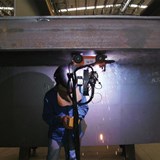Automated welding equipment, although available for decades, advances each passing year in terms of control technology that improves welding control, capabilities, consistency, and spend. As welders face difficult applications, they use automated options whenever they can in order to mitigate health risks, work in confined areas where positioning can be a challenge.
Brazilian company, Uniarc, has introduced a new piece of equipment to this market called the Oscimatic tractor. The remotely-controlled unit uses the force of magnetic attraction, rather than a mechanical system, and travels in variable speeds on ferrous surfaces to accomplish difficult welds. The Oscimatic was built to travel on linear courses and uses a set of motorized cursors in the horizontal and vertical directions to position the torch before and during the weld. The standard version has an oscillator that performs the wave motion responsible for the shape and geometry of the weld bead.
Although the unit is not steerable, the torch can compensate if the units direction of travel is not perfectly aligned to the weld seam. Its straight-line motion proves to be beneficial.
As a programmable unit, the Oscimatic works in confined spaces, and performs long, complex welds, which means it is well-suited for large projects involving code welding, such as tanks and pressure vessels.
While the units permanent magnets make it ideal for welding on steel alloys, this is not a strict limitation. It can be used on stainless steels and aluminum alloys in the flat position and special circumstances. Its magnetic fastening system does not transfer magnetism to the base material, so it does not have an impact on the welding process.
On ferrous materials, it can weld in any position as long as the tractor can grip the material, and in its standard version, can perform inside a gas sphere or a tank dome.
Due to the operators ability to work remotely, the risks associated with the welding arc, heat, and fumes are minimized. The programmer does not have to limit the voltage and current parameters in consideration of the operators health, safety, and comfort. The programmer can program the machine for the highest possible deposition rates, limited only by the equipments capacities and the consumable ratings.
Image courtesy of FMA thefabricator.com

